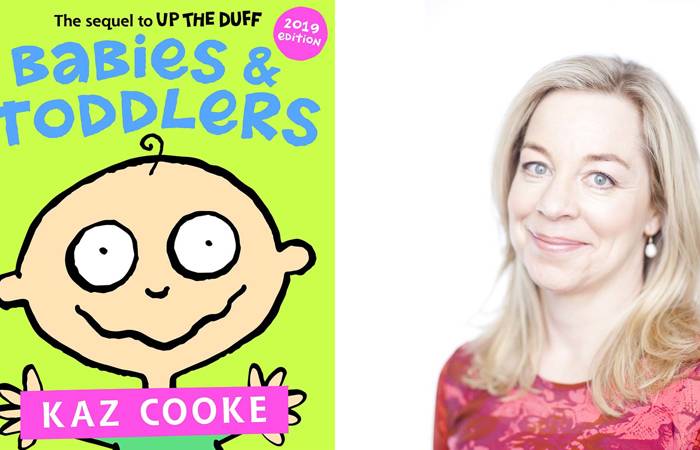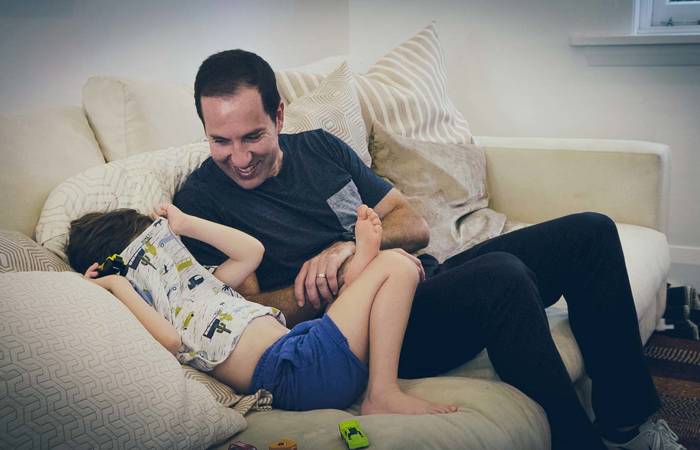Like what you see?
Sign up to receive more free parenting advice.
Thank you for subscribing to our newsletter!
Child Development

Credit: iStock.com/StefaNikolic
Associate Professor Richard Fletcher has been conducting research with fathers and families for over 20 years. He began the SMS4dads text-messaging program and is co-convenor of the Australian Fatherhood Research Network. In this article he looks at how fathers can build secure bonds with their children.
A father posted this plea on a website for new dads:
‘I’m just coming back from being over in Iraq, and my daughter, who is only six-and-a-half months old, doesn’t stop crying whenever I hold her. The moment my wife is out of her sight she starts crying, and the longer I’m holding her the worse she gets. My upstairs neighbours said it sounds like someone is trying to kill her. I don’t know what to do. I’ve tried holding her and letting her cry until she stops, but like I said, her crying just gets worse. I want for us to re-bond so bad that every time she cries, I cry. If any of you guys can give me any advice, I’m more than happy to take it.’
What is missing here? This father is trying hard to make the connection with his daughter. He perseveres even when the crying gets worse and his emotions are fully engaged. What no one has told him is how he can make that connection. Three pieces of information could make all the difference to this father:
- Knowing that it is usual for babies to react to strangers (anyone that they don’t know well, after about six months of age), might help this father relax a little when he is trying to hold his daughter.
- If he understood that bonding happens though brief, repeated interactions in routine care (things like dressing, feeding and changing her). He might see how to get close to her by caring for her, not just holding or playing with her.
- Knowing that his relationship with her will have an effect on the connections in her brain and that will influence how she deals with stressful situations in the future. This might help him to keep trying.
Not just any bonding will do
If you are there with your baby in a caring role, then forming a bond is pretty much guaranteed. Babies depend on the adults around them for survival.
Even if your time to be father most days is limited to bath time or a quick story before sleep, you will still form a bond.
You’ll notice this as soon as your little one can walk. The moment they become anxious or scared, they will gravitate to your leg or arm or any part of you within reach. Beside you, holding onto you or in your arms is the safe spot, the only place that they want to be when the world seems unpredictable or dangerous.
What research has shown, however, is that just having a bond (called ‘an attachment relationship’ in the scientific writing) is not enough for a baby to develop into a competent, confident child and adult.
The bonding that seems to give a baby the best chance to manage all the twists and turns of growing up is best described as secure bonding.
When the relationship between a father and a baby gives the baby a ‘secure base’ to explore the world, safe in the knowledge that their dad will ‘be there’ when needed, the child forms a secure bond. If the baby does not have the feeling of security to go off exploring the world, the bond is insecure.
How can you tell if a bond is secure? In a common test used by researchers1 a one-year old comes with their parent into a room where there are some toys. After a while the parent leaves.
Naturally enough, we’d expect the infant to be upset and, when the parent returns after a short time, we expect the child to want reassurance by being comforted.
When the sequence is videotaped you can often see exactly this process; the baby cries when the parent leaves and then goes to them when they come back and settles down.
These toddlers are said to have a high-quality bond, or a ‘secure’ attachment relationship, with the parent. After being comforted for a short period of comfort, these babies quickly get back to exploring the toys and the room.
You’ll notice this as soon as your little one can walk. The moment they become anxious or scared, they will gravitate to your leg or arm or any part of you within reach. Beside you, holding onto you or in your arms is the safe spot, the only place that they want to be when the world seems unpredictable or dangerous.Dr Richard Fletcher
Stay up to date with the latest news and articles from First Five Years
Thank you for subscribing to our newsletter!
The benefits of high-quality bonding
However, there are some babies who show clear distress when the parent leaves, and yet hardly react when they come back.
This behaviour was first thought to show that the infant was very independent and not at all needy. But when they were observed more carefully, it was realised that these children appeared not to care about where their parent was because they had shut down their emotions.
When the parents of these infants were observed at home it was noticed that they discouraged their infant from approaching them when they were upset.
Instead of offering comfort, they said things like, ‘Oh look over here at this,’ or ‘Here’s something for you’, trying to distract the child; or even became cross at the child, telling him not to be ‘a cry baby’.
Babies who react to the parent leaving as if it is not important are said to have a poor quality bond or ‘insecure’ attachment relationship.
Although these babies play with the toys when the parent leaves, the quality of their play is less imaginative and exploratory than babies in the high-quality bond group. But the impact of a poor quality bond lasts way past infancy.
Studies over the last five decades show that high-quality bonding2 with a mother or father can help their infant manage stressful situations more effectively. If, as infants, they can express their fears and gain the comfort they need from their parent, this helps them manage their emotions and continue to explore their world.
As children and teenagers, they will be more likely to be successful since they will be better able to manage the normal difficulties of school, and they will form friendships more easily.
If your baby could tell you how to bond here’s what they might say:
- Just remember dad, I am trying to bond with you too. We’re on the same team.
- All the regular stuff like changing me, bathing me, feeding me, is how we get to know each other.
- The way that you play with me helps me build up brain connections, so thanks dad.
- When you are with me don’t just watch what I do, try to guess what I am thinking.
- It is OK if you and mum do things differently. I can bond with both of you. That’s how clever I am.
1 Lamb, M. E., Thompson, R. A., Gardner, W. P., Charnov, E. L., & Estes, D. (1984). Security of infantile attachment as assessed in the “strange situation”: Its study and biological interpretation. Behavioral and Brain Sciences, 7(1), 127-147.
2 Ainsworth, M. D. S. (1991). Attachment and other affectional bonds across the life cycle. In C. M. Parkes, J. Stevenson-Hinde, & P. Marris (Eds.), Attachment across the life cycle (pp. 33-51). New York: Routledge.

Dr Richard Fletcher
Richard Fletcher is Associate Professor, Brain and Mental Health Priority Research Centre, Faculty of Health and Medicine, The University of Newcastle.
See more






